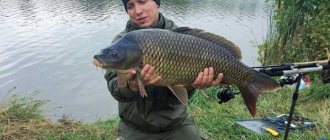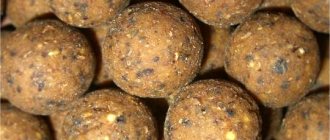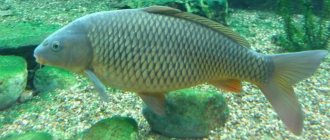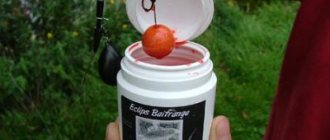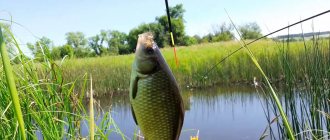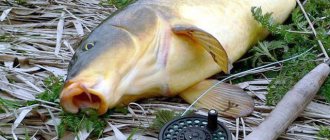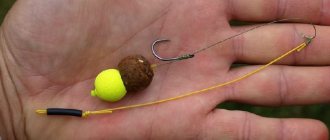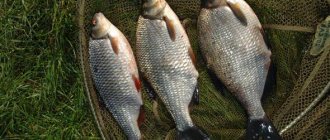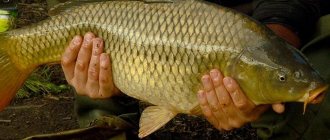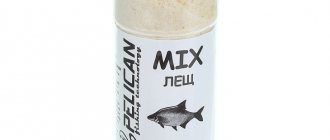Attractants for carp.
To catch more carp, you need to add attractants to your bait. But not all attractants work well in different places. Basically they are made according to a standard formula, for all types of fish and for general conditions - carp fishing. When experimenting with attractants at specific carp fishing spots, we lose a lot of time, and if we use the attractant incorrectly, we can simply scare the carp away from the chosen fishing spot. There is only one way out - you need to use an attractant you made yourself. Such an attractant will be effective when fishing for carp in a given place and at a given time of year.
When I decided to make my own boilies for bait, I began to seriously study the composition of the ingredients, smells and tastes of various attractants and flavors. I spent a lot of time experimenting with all types and flavors of different baits and the results showed. I decided to start making attractants with my own hands.
I already knew quite a lot about mixtures, bait preparation, bait density, making floating boilies, etc. The key element for creating an effective and high-quality attractant with your own hands was several problems associated with the use of branded attractants. In particular, the aroma is too strong and the attractant disappears quickly. Some bakers suggest shortening the boilie baking time because high temperatures neutralize some of the flavors.
Some suggest using odorless boilies and soaking them with an attractant only before fishing. But again, as I said earlier, the initial aroma is too strong, the concentration of the smell at the fishing spot is very strong. Carp don't like it when something smells too strongly, it scares it away. Having some experience using attractants and flavorings for bait, I started experimenting with different flavors to see what happened.
On my last fishing trips, when fishing for carp, I caught 80% of all fish using neutral boilies, for which I used an additional attractant. Before fishing, I treated all the boilies with an attractant and then froze them in bags of fifty pieces in the freezer. For fishing, I took only the amount that was necessary for the entire process of carp fishing; the rest was stored in the freezer.
Attractants and liquid attractants in carp baits
In this article we will talk about carp baits and the use of various liquid attractants in carp fishing, and we will also look at recipes with which you can independently prepare some liquid attractants from natural raw materials.
The importance of liquid attractants in terms of their effectiveness in fishing in general, and in carp fishing in particular, is very difficult to overestimate. And this is explained by the fact that fishing takes place in a liquid medium - in water. The mechanism by which odors spread in water and air has significant differences. Odor-carrying molecules that are perceived by the human olfactory organs, with very rare exceptions, are volatile and have good solubility in organic solvents, but poor solubility in water.
The sense of smell of fish is their ability to recognize specific substances found in low concentrations in water. Olfactory receptors are highly sensitive and selective; they are able to capture individual molecules of a substance in a large volume of water. Using the sense of smell, fish can determine the location of potential food by its smell, guided by the concentration gradient of the latter. In simple words, following the stream of smell in the direction of increasing its intensity, the carp comes to the food that emits this smell.
Thus, in order for the fish to smell the attractant used by the fisherman, it must first dissolve in the water. With rare exceptions, liquids dissolve in water faster and more completely than solids, which is why liquid attractants are highly effective and have the ability to attract the attention of fish very quickly.
Any water-soluble components of baits, even those that have a very weak odor or no odor to our sense of smell, can be successfully detected by the carp’s olfactory system in minute quantities. Especially if they belong to certain classes of substances that have a particularly strong effect on the carp’s sense of smell. These substances include, for example, amino acids, fatty acids, quaternary ammonium salts and other chemical compounds.
Both products obtained from natural raw materials (for example, beet and corn syrup, corn liquor, various seafood extracts, vegetable and animal fats and oils) and products of chemical origin (for example, dips and boosters based on artificially synthesized flavors). It is difficult to say which of these two classes of attractants is more effective; too much is determined by the specific situation that has developed in a given place and at a given time. In my opinion, attractants based on natural raw materials are more effective from an integral and long-term perspective, since the molecular structure of natural compounds makes them the most suitable “keys” to the “locks” of carp receptors. Therefore, carp are more likely to detect these substances once they are dissolved in water.
Chemical flavors are complex mixtures of natural and synthetic constituents (for example, esters). I don’t think anyone can answer unequivocally how their effectiveness is achieved. It is possible that molecules of successful flavors also “suit” the olfactory receptors of carp, causing their response and, as a result, interest in the bait.
Next, we will briefly consider the features of using various types of liquid attractants.
Among the most common, inexpensive, but at the same time quite effective liquid attractants, we can probably safely include beet and corn syrup. Many Western companies offer these products (sometimes in a slightly modified form) at a very high price, while ordinary domestic molasses offered by domestic manufacturers (for example, Rocket Baits and Carp Baits) works no worse than imported ones, but costs much less.
Beet molasses or molasses is one of the most valuable wastes of beet and sugar production; it is a thick, opaque liquid from brown to dark brown in color, with a specific odor and a sweet taste with a bitter aftertaste. Beet molasses dissolves very well in both hot and cold water. It contains a large amount of sugars and from four to seven percent betaine, the attractiveness of which to carp is well known.
Just like corn syrup, molasses can be successfully used as a base for making instant boilies yourself. Moreover, if boilies based on corn (maltose) molasses turn out to be quite hard, then baits based on molasses remain plastic even after drying. Particularly good results in my practice were shown by instant boilies based on beet molasses, in which the main nutritional component was chicken liver, both in the form of minced meat and in the form of powder.
Beet molasses can serve as an excellent addition to various grain mixtures. Molasses can also be used in the fermentation of grains as a nutrient for the bacteria involved in the fermentation process. In addition, beet molasses can be used as a dip for impregnating baits or a booster for impregnating various types of bait, in particular pellets. As mentioned above, molasses dissolves well even in cold water, so it can be used throughout the season.
Corn syrup contains reducing sugars, namely maltose and glucose, which are the most easily digestible carbohydrates for carp. The digestibility of maltose is about 92%, and glucose is close to 99%. Apparently, this is precisely what determines the attractive ability of corn syrup. Most often, corn syrup is used as a liquid base for the production of soluble boilies, but the possibilities of its use in carp fishing are far from limited to this. Using the property of maltose molasses to crystallize when dried, turning into a kind of candy, you can achieve very interesting effects.
I have already written in my articles about dip for baited boilies based on maltose molasses and its natural attractiveness, however, let me once again briefly dwell on the technology of using such a dip, which makes it possible to very effectively highlight the bait at the bottom of the reservoir.
Read: Catching carp in spring with a float
To one hundred and fifty grams of maltose molasses add two to fifteen grams of warm mineral water without gas, in which we first dissolve a teaspoon of soluble fish protein. Next, add three teaspoons of a base mixture to the resulting solution, similar to the one from which the boilies are made. When using factory boilies as attachments, instead of the base mixture, you can use attachment boilies ground into dust using a coffee grinder. Then add a teaspoon of Robin Red, a teaspoon of liquid dye (if desired), a teaspoon of ground wheat germ, five grams of the appropriate flavoring. Mix everything thoroughly.
To one hundred and fifty grams of maltose molasses add five to ten grams of corn liquor, five grams of liquid brown algae extract. three teaspoons of base mixture (similar to what bait boilies are made from), a teaspoon of liquid coloring (if desired) and three grams of the appropriate flavoring. Mix everything thoroughly.
The dip turns out gel-like. You can apply it to the surface of the bait (as well as the PVA stick) immediately before casting, but it is better to do the following.
Pour a small amount of dip into a wide, low, hermetically sealed container (plastic jars in which cut herring and other food products are sold work well for this purpose). Place enough boilies into the container so that they fit on the bottom in one layer. Close the container with a lid and apply the dip to the surface of the boilies, making vigorous circular movements with the closed jar and turning it upside down from time to time.
Then the boilies must be dried and their surface saturated with particles of the base mixture (and/or some powdered attractant). This is convenient to do on the lids of plastic buckets. Pour the base mixture onto the lid, place the boilies on it and roll them over the lid so that the base mixture sticks to the entire surface of the boilies. Leave the boilies to dry on the lid for two to three days. Roll them periodically to turn them the other way. After the boilies have dried, repeat the dip application procedure and dry them again; having previously applied the 6a mixture to the surface. Repeat the procedure one or two more times. This way you will create a fairly thick outer layer on the surface of the boilie, which upon contact with water will instantly begin to dissolve, sending a powerful attractive signal.
As I have repeatedly noted, giving all elements of the bait and bait program a single smell helps to increase its overall effectiveness. To impart a smell similar to the boilies used, to such components of the bait program as grain mixture, bulk bait, pellets, you will need a booster. Booster (and dip) can be made using chemical flavors. This need may arise when you only have a flavoring agent for making boilies, but there is no way to purchase a dip or booster with a similar scent.
To achieve the required concentration and increase the volume (which is necessary for a more uniform distribution of the odorous substance throughout the entire volume of the bait), chemical flavors are dissolved in propylene glycol, isopropyl or ethyl alcohol, glycerin, diacetyl, triacetin or purified oils. The physicochemical properties of the solvent affect the properties of the flavor as a whole. For example, glycerin, due to its sweetish taste, has masking properties that make it possible to compensate for the harsh taste of most chemical flavors. Glycerin has emulsifying properties, so essential oils dissolved in it create emulsions that spread well in water. In addition, it is a good solvent and itself has excellent solubility in warm water. But at low temperatures, glycerin thickens and dissolves poorly. Therefore, when making dips and boosters for use in cold water, it is better to use ordinary ethyl alcohol as a diluent.
To create a booster, you need to add about five grams of flavoring for making boilies per one hundred grams of base and mix thoroughly (for dip, you can use up to ten grams of flavoring per hundred grams of base). In this case, it is better to use weight rather than volumetric units. The booster should be stored in an opaque sealed container.
By the way, sometimes the opposite problem arises - there is a dip and a booster with the desired smell, but the corresponding flavor for making boilies either simply does not exist for sale, or you do not have the opportunity to purchase it. This situation is not critical - boilies can be successfully made using them as a flavoring agent as a dip. so is the booster. You just need to properly increase the amount of fragrance carrier (and remember to reduce the proportion of liquid base accordingly), since dips and boosters contain it in much lower concentrations than in specialized flavors. Some companies (for example, Rod Hutchinson and Dynamite Baits) even indicate on the labels of some of their dips and boosters their dosage recommended for making boilies (usually the dosage is indicated per one or more eggs).
But let's return to maltose molasses. In my opinion, enormous possibilities arise when it is used as a binding component for the manufacture of bait balls. Very often, it is convenient to feed with the help of bait balls, rather than rockets, but this involves the use of a large amount of loose bait, which is necessary in order to bind the remaining bait components into a ball, which is not always acceptable due to the presence of a large amount of small or unwanted food in the reservoir. fish. When mixing bait balls not with water, but with maltose molasses slightly diluted with it, the bait can be formed into a ball using a minimum amount of bulk bait. Such a ball turns out to be very dense (much heavier than one mixed with water at the same size) and, accordingly, has excellent flight characteristics. In addition, by changing the proportions of water and molasses, you can vary within very wide limits the time after which the ball begins to disintegrate at the bottom of the reservoir. This is especially true at night, when it is prohibited (for example, at sports tournaments) or undesirable to use noisy methods of delivering bait to the fishing area.
Read: How to store natural baits
By using balls with different dissolution times, you can, by feeding the fishing zone once, ensure the presence of a strong food signal in it for a sufficiently long period of time. In my opinion, particularly interesting results can be achieved by creating “long-lasting” balls, consisting primarily of pellets of different sizes (or with different dissolution times).
But the range of uses of corn syrup is not limited to this. By diluting it with water (or glycerin) and adding flavoring, you can make a syrup for soaking boiled bait boilies (as Rocket Baits does for its line of products “Bait Boilies in Syrup”). Boilies should be stored in syrup at all times. True, after some time they become quite hard and require preliminary drilling before attaching to the hair, but this more than pays off by increasing the efficiency of such an attachment.
Another way to use corn syrup in the process of making boilies is as follows. Try boiling boilies not in water, but in maltose molasses slightly diluted with it. I think you will be pleased with the result.
Essential oils are an odorous mixture of liquid volatile substances obtained from natural plant materials. Essential oils have antioxidant and immunomodulatory (stimulating the immune system) properties. Certain essential oils (for example, anise) stimulate digestion. Essential oils are poorly soluble in water, so for them to work effectively in carp baits they must be emulsified. It is no coincidence that when making boilies, essential oils (as well as any other liquid aromatic additives) are recommended to be added to eggs. Egg yolk contains a large amount of lecithin, which is one of the best natural emulsifiers.
Essential oils can be successfully used in homemade glycerin-based dips and boosters, since glycerin also has good emulsifying properties.
There is a hypothesis that some essential oils (or mixtures thereof), due to the similarity of their molecular structure with natural compounds, can effectively stimulate carp receptors, causing it to turn on its food-seeking mechanisms. In my experience, black pepper and asafoetida oils are the most effective.
Fish oils, rich in unsaturated fatty acids, are very strong attractants for carp. In addition, fish oil spreads well in various layers of water (up to its surface), quickly and actively attracting fish to the baited area. The most effective fats (either alone or in combination with each other) are salmon and halibut fats, as well as cod liver oil.
In cold water, the efficiency of fats is significantly reduced due to the fact that under the influence of low temperatures they thicken and spread very poorly or not at all in the water. To solve this problem, you need to create a water-fat emulsion. An emulsion is small particles of one liquid evenly distributed in another. A typical example of an emulsion is regular milk.
Under normal conditions, fat and water do not mix. To make a water-fat emulsion, we need a special substance called an emulsifier. There are a large number of different emulsifiers, including those produced by companies specializing in carp nutrition (for example, Nutrabaits). I personally use xanthan gum as an emulsifier, made by fermenting glucose or sucrose with the bacteria Xanthomonas campestris. And although by its nature xanthan gum is more of a thickener than an emulsifier, it is quite suitable for our purposes, and in addition, it is harmless and approved for use in human products.
The sequence for making the emulsion is as follows. To a teaspoon of xanthan gum add 20 grams of fish oil and 20 grams of water. Mix the ingredients thoroughly with a fork until a homogeneous mixture is obtained. Add a teaspoon (without a slide) of dry bead dye (or 8-10 grams of liquid) and mix thoroughly again. To the resulting colored mixture add 460 grams of water, 20 drops of black pepper essential oil (or the same amount of asafoetida essential oil), 5 grams of flavoring for boilies (the same as was used for making boilies), one or two drops of butyric acid and again to stir thoroughly.
In a similar way, you can prepare emulsions from such strong attractants as linseed and hemp oils, as well as from fragrant unrefined sunflower oil.
Fish lives in water. Water is one of the best solvents for various chemicals, so fish are forced to live in a kind of chemical solution with variable properties. The entire life of a fish takes place under conditions of a strong chemical “background”. If fish had not learned to very selectively evaluate the chemical signals around them, they would not have been able, for example, to find food by its smell, which is essentially a chemical signal from food components dissolved in water, among the background signals inherent in any body of water.
Read: How to feed carp
Therefore, carp receptors have significant selectivity towards various chemical compounds. Natural attractants, due to their specific molecular structure, are very well detected by the chemoreceptor system of carp, therefore such substances are very effective in almost any fishing conditions. In addition, when using natural extracts from natural raw materials (as opposed to chemical attractants), there is virtually no danger of exceeding the required dosage, thereby turning the attractor into a repeller.
The most effective natural extracts include extracts from mollusks and crustaceans, internal organs of animals (for example, liver), grains and nuts. The most famous and widely used natural extract is perhaps an extract from corn, known among carp anglers as corn steep liquor.
Natural extracts can be included in boilies (by adding them to the liquid base), as well as in dips and boosters. In addition, natural extracts can be used to impregnate bait, fermented and cooked grains, pellets, as well as mix bait for PVA sticks in its original form.
Liquid attractants based on artificially synthesized substances, both in pure form and in combination with natural attractants, under certain conditions, can be very effective in attracting the attention of fish. Among this class of attractants, amino acid complexes are perhaps the most effective.
Free amino acids belong to the class of substances to which the carp chemoreceptor system reacts most strongly. Therefore, carp easily detects them from a fairly large distance, where their concentration in the water is extremely low. Therefore, specially selected amino acid complexes can serve as attractants that quickly and effectively attract carp to the fishing zone. At the same time, when in contact with oxygen, amino acids undergo chemical changes quite quickly, so I would not recommend including them in boilies at the stage of their manufacture. In my experience, a much greater effect can be achieved by impregnating baits and baits with amino complexes immediately before using them.
Liquid amino acid complexes should be stored correctly. If you have opened the bottle and poured some of the liquid out of it, before screwing on the cap, squeeze the container so that the liquid fits under the edge of its neck and only then screw on the cap. This will remove unnecessary air from the container and slow down the chemical changes in its contents. Try to take with you exactly as much liquid amino acids as you plan to use on the pond (it is very convenient to use disposable syringes of the appropriate volume to transport them without air access), leaving the main supply to be stored in a cool, dark place. When fishing, do not expose liquid amino acids (as well as any other liquid attractants) to direct sunlight. Try to keep all liquids in the shade, or even better - in a special thermal bag.
Liquid amino complexes can serve as a good addition to the composition of self-made dips and boosters (it is also advisable to add them last, immediately before use).
Butyric acid belongs to the group of fatty acids, to which the carp chemoreceptor system is particularly sensitive. I don’t think anyone would think of calling the smell of butyric acid pleasant, but carp can detect it dissolved in water in minute concentrations. In addition, butyric acid, when included in the bait, lowers its pH, and carp are known to sense any changes in the acidity of their environment very well. In my experience, baits with butyric acid are most effective in reservoirs whose water pH is shifted to the alkaline side.
However, butyric acid should be used very carefully. First, make sure you follow the recommended dosage. Secondly, when making boilies, do not add butyric acid directly to the eggs, otherwise they will curdle. First, dilute the acid in some liquid (for example, CSL or just water) and only then add it to the eggs. Thirdly, try not to work with butyric acid indoors and store the bottle of it in some kind of airtight container (at least in a ziplock bag). Otherwise, its strong and unpleasant smell can ruin the life of your family.
Butyric acid can be used not only in boilies; it can be included in boosters, dips, and liquids for mixing bulk baits.
Betaine is a natural substance found in animals and plants and was discovered by Scheibler in the juice of the sugar beet Beta vulgaris in 1866, from which it gets its name. Betaine is perhaps the most well-known and frequently used attractant in carp fishing.
Liquid betaine is much more convenient to use than powdered betaine, since the liquid is easier to distribute evenly throughout the carp bait. And if we are talking about including betaine in self-made dips and boosters, then the advantages of the liquid form of this substance are beyond doubt.
Betaine is not only a very effective attractant, but also, to some extent, an appetite stimulant for carp fish. Like many other attractants, it shows the best results in a certain concentration. At the same time, a smaller dosage reduces the attractive ability of betaine, and its excessive amount can scare away fish (therefore, when working with attractants of a chemical nature, it is always better to underfill than overfill). The normal dosage of liquid betaine is 20-30 grams per kilogram of boilie base mixture (or kilogram of any type of bait).
Ringing forests for you!
Types of attractants.
So what is good taste and smell? There are three types of scents that work differently. The first type is aroma, which has a rapid distribution in water and a strong concentration. It quickly disperses, warning with its smell about the presence of fish food. The second type of attractant has a somewhat slow effect. It dissolves slowly, giving time for the fish to get used to the smell. The third type is an attractant that remains in the bait as long as possible and, released during the dissolution of the bait, creates an aura of attraction around the boilie. This is the attractant that is actually the best and makes the carp suck the bait.
My research has shown that exposing an attractant to thermal influences renders it unusable. In fact, heat destroys the active volatile substances of any attractant. This means that cooking bait is not suitable. But we need to make the bait more complex to protect it from small fish. What a conclusion - adding flavor after cooking! This is done by immersion, soaking the bait in the attractant. You can also freeze scented bait. The freezing process will not damage the aroma of the attractant.
I have heard from many fishermen, “But why is the internal aroma not as good as the external one?” My personal opinion, given that the bait usually consists of only a natural mixture, such as fishmeal and grains, for example, the external aroma is good because it can be applied as much as you need. Elementary, thereby saving a huge amount of attractant. But think for a moment about the benefits of liquid without bait or boilies.
By creating an attractant with your own hands, you can have the bait in countless variations of aroma and taste. Take only as many boilies as you need to catch carp, saturate them with a home-made attractant, and place them in the freezer for several hours so that the boilies absorb more aroma. Almost all carp anglers I know who have tried this flavoring method have had good results in catching carp.
I should make a quick note here. Why sometimes we don't have positive results when fishing for carp.
1) the aroma of the attractant quickly disappears.
2) the aroma of the attractant is not suitable for carp.
3) the process of dissolving the bait and releasing the attractant is very long, the carp remains indifferent.
4) The bait has foreign odors; this happens when other products are kept in the freezer.
I am shocked at the quality of some of the attractants that are offered for sale. There are some flavors that contain 2% flavor and 98% filler. There are attractants that are actually a copy, but with a different name and different colors. There are only 7 or 8 good attractants on the market, and the rest are variations on one theme or another under different names.
There are liquids that do a great job - these are oil-based attractants. They are very dense, dissolve very slowly in water, and have an excellent taste and smell. Flavors based on the famous PG (Propylene Glycol) are water soluble. Those attractants that are based on EA (Ethyl alcohol) are super water soluble. And I realize that I am repeating myself, but freezing alcohol-based attractants significantly improves the retention of aroma during long-term storage of the bait, which leads to a greater likelihood of carp approaching and biting.
Types of carp attractants
There are a great variety of attractants for carp. The variety of flavors is simply enormous. These can be fruity scents (usually pineapple mixed with other exotic fruits), simple vanilla (any vanillin-based scent), or natural scents (among the latest innovations are attractants with the scent of fish caviar). In each individual lake, pond or river, one or another smell can become decisive. Therefore, recommending the aroma of an attractant is a thankless task. But, at the same time, it is important to remember that the quality of the attractant is determined not only (and not so much) by the smell itself, but by its general composition. Therefore, all commercially available attractants should be divided into high-quality “liquids” and “handicrafts”.
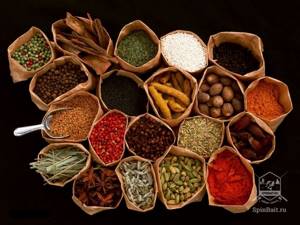
It is also important about attractants. Attractants are divided into “winter” and “summer” - for cold and warm water. The basis of “warm water” attractants is glycerin - a substance that perfectly preserves the taste properties of the components, but is relatively poorly soluble in cold (below 15 degrees) water.
The best attractants in carp fishing.
When I started carp fishing at one of the local ponds a few years ago, in the early days of fee fishing, it was relatively easy to catch carp. Sweet corn, dough, boilies treated with those attractants worked with a bang. This is understandable. Very few attractants were produced back then, and they were actually of excellent quality. And the carp was not spoiled by the smells of attractants.
For the carp, all these smells and tastes were like a delicacy in a restaurant. He responded very readily to the tasty smells of attractants. After several years, the carp became more distrustful of baits treated with “chemicals” and began to bite less often. In a conversation with a colleague about the situation that it is already so difficult to catch carp on the fishing grounds that the fish does not want to respond to any bait, he told me that he had also already tried everything. And then he took a bottle out of his pocket and, showing it to me, said, “But this works, and even very well!” I was convinced of this by spending 2 days fishing with him.
Now this is no longer a secret, but then this attractant was new, and those who knew and used it were kept secret. It was the Ultrabyte attractant. An attractant produced by the English company Cefas, which synthesized and launched into production an attractant with pheromones not only for carp, but also for many other fish. I still use the Ultrabyte attractant and it has never let me down. But here’s another case when I was surprised by another friend of mine, with whom we had not seen for several years.
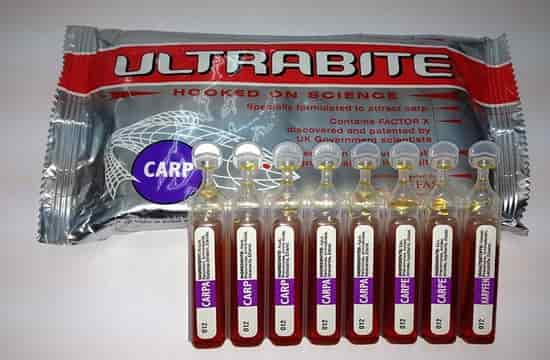
We met him by chance, on one of the wild lakes. I wanted to catch real, wild carp or carp. I had to climb into such a wilderness where it seemed that no human had ever gone before. It may not have been trodden by a human being, but there were definitely fishermen here, and one of them was my comrade. We again touched upon the topic of why carp became difficult to catch. Then he took out the bait and dipped it into his bottle with some liquid. This liquid smelled quite pleasant, not like Ultrabyte. I couldn’t believe my eyes when literally 15 minutes later he pulled out more than 5 kilograms of carp.
I asked him what it was and he told me - “Handmade attractant.” The flavors that were mixed there were strawberry and honey. It smelled divine! So this was my first tutorial for making my own attractant. The next time I went carp fishing I had my attractant in my pocket. I used strawberry jam and honey and added a little sunflower oil to thin the mixture. This fishing trip was a complete success, I caught more fish than I had caught before, not counting the fishing trips where I used the Ultrabyte.
DIY attractant.
Of course, after all these experiments, I became more selective in choosing attractants. Although, to be honest, I only use Ultrabyte from the purchased ones. I make all other attractants for carp fishing with my own hands. Of course, you can go to a fishing store and buy attractants and flavors for all occasions. But I’m more than sure that 90% of these liquids will just be lying around in your bag. I don’t see a problem, everyone can make any attractant with their own hands that will be 100% working.
Here are some ideas to get you started experimenting and getting better at catching carp. As soon as you learn, you will be able to make your own experimental combinations, which will bring better results and will allow you to catch carp not only more often, but also trophy specimens.
The first thing you need is a base, a liquid that will accept and hold the scent of the attractant. This could be olive oil or sunflower oil, or my favorite, sesame seed oil. The base flavor may be canned corn juice. This is a taste that is well known to many generations of carp, and every year hundreds of fishermen catch large carp using canned corn. If you want an attractant that tastes like fish meat, try adding oil from a can of canned sardines or sprats.
Once you've made your liquid base, you can add your own flavors. For a sweet mixture, try adding almond butter, flavors like strawberry, vanilla, peach, chocolate, or whatever you think will work well. Honey is a good sweetener. Sweet syrups are also a useful addition. A spoonful of syrup has a wonderful effect and helps thicken the sweeteners. If you want to achieve a spicy aroma, you need to add chili pepper, curry and garlic.
For summer carp fishing, when the water temperature is high, I work with oils used as a base, because the oils flowing off the bait spread across the surface, in the form of an oil, which attracts the carp. In cold weather, I'm willing to bet the attractant treated with will still be concentrated around the bait. In this case, sweet corn juice is a good option for a homemade attractant. The juice from fermented corn or other grains is also a good base for a liquid base used during the colder periods of the year, fall and winter.
Remember that you should not make attractors too easily soluble, this means that the denser the liquid, the slower it will be released from the bait. If you want a stronger aroma, you need to soak the bait at home, then freeze it and before using it, put it in a warm place for a while, but not in the sun. Although I do not defrost soaked and frozen boilies. Since they will defrost in the water, the smell and taste will slowly disperse near the bait, creating a longer work of the attractant.
Just remember one thing, don't overdo it with the flavoring. This can only lead to scaring away the carp. And remember, not only boilies can be seasoned and soaked. Regardless of the bait, you can try soaking any bait with an attractant and flavoring. Also, try to keep your bait with honey or jam. Two substances that are dense and sweet, the carp will not ignore them.
So, having a good understanding of the assortments of products and seasonings in your kitchen, you do not have to go to the supermarket to buy ingredients for a homemade attractant. With a little experimentation, Fortune can be on your side when fishing for carp, and you can gain an advantage over your fellow fishermen targeting the same pond or lake.
Bait for carp.
Thus, in your search for new flavors, you have found a can of cat food “E-Kat Kit”, which, when mixed with bait, gives an amazing effect, even in the most unfavorable carp fishing conditions. I also often add a bag of dog food to the bait.
Powdered sugar creates a sticky mixture. Corn flour, milk powder, sugar, ground barley, all these are ideal components of a good carp bait formula. In any case, all of us fishermen also use various food seasonings. You can read about the use of such seasonings in my previous article “Do-It-Yourself Bait.”
In general, most baits are available today in a wide range. Their companies spend a huge amount of work in the development and production, and the merits of these baits should not be underestimated. There is a widespread opinion among fishermen that today the production of bait cannot do without the strong intervention of chemistry in order to obtain the best effect for attracting carp and fish in general. Perhaps the creation of boilies also gave impetus to the turbulent growth in the production of attractants and flavors.
The list of baits is starting to seem endless, and more and more new versions of mixtures for carp fishing appear almost every month. The main factor is that not all, but only some, are truly unique baits, created by trial and error, with an amazing ability to lure carp. They usually use natural ingredients for taste and aroma. In practice, the vast majority of available baits for carp have two sides. The advantage is a large selection of flavors.
But is this really necessary? The downside is that many bait manufacturers try to use too many flavors and mixtures without making an attempt to understand their effectiveness. Many anglers want to have all the flavors in just one bait, not thinking that this killer mixture will only scare away carp and any other fish. Another group of fishermen complain that buying a certain scent in bait acts as a repellent, that is, it drives away all the fish. Usually, once it becomes clear how they used the product, everything falls into place.
Use of flavoring ingredients
Since carp have a keen sense of smell, which is vital for finding food, determining the safety of water composition and other vital functions, an incorrect ratio of aromatic substances or an excessive amount of them can repel the fish. In addition, factors such as:
- special conditions of the aquatic environment where fishing is planned - this is mainly the main composition of the fish’s food, inherent in a particular reservoir;
- external conditions - weather and season of the year and the activity of carp correlated with them; in heat and cold different habits and attracting components are required;
- subjective preferences of the fish depending on its mood: carp can be caught wonderfully on bait with a vanilla scent, and a few hours later not pay any attention to it.
The conclusion is that if you are successfully fishing with one flavor, you should not use it constantly - it may not work and there are a variety of reasons for this.
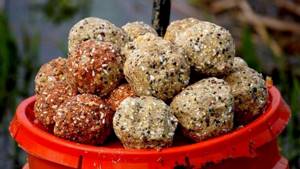
It has already been said that you cannot use a large amount of attractants - this scares away aquatic inhabitants, so there are standards for 500 g of any mixture. Essential oils, since they are the most saturated with aroma, require no more than two or fewer drops. If cheese ingredients are used, then only 1 ml is needed. Other similar substances that do not have such a strong odor can be used in an amount of 5 ml per 0.5 kg of bait.
Flavorings for carp.
Now let's talk about the aromas used in branded baits and their use as flavoring agents. Most flavorings sold today have not been tested for their effectiveness in attracting carp. They are mainly developed on the basis of chemicals rather than natural substances, and therefore have a very high concentration of odor, sometimes exceeding 1000 times! Some carp anglers do not wisely “bathe” their bait in “syrup”. Can you imagine what effect this “flavor” will have on carp? Smell the contents of one of these bottles and you will understand!
It has been proven that carp can sense scent diluted to 1,000,000! This means a drop of your favorite flavor needs to be diluted in 5 liters of water. Now we can think about why, using such flavorings, we return from carp fishing with nothing. Finding 1000 reasons for poor carp activity.
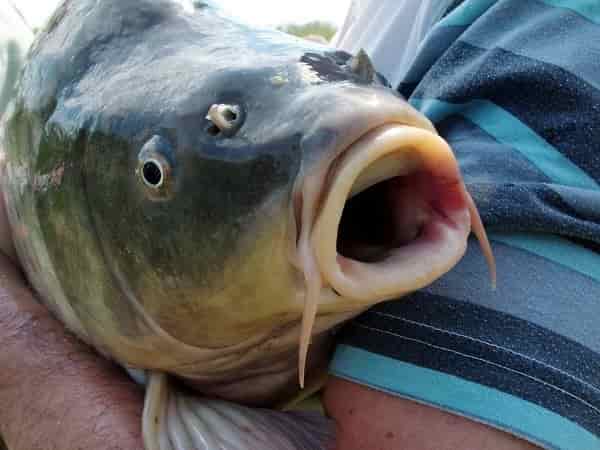
Incorrect use of scents is one of the reasons for unfair reproaches in carp fishing. This applies not only to specially developed flavors for fishing. This also applies to baits made by supposedly reputable companies. But in the end, these are baits that are simply made by wrong manufacturers, instead of luring carp, on the contrary, they scare them away. And what distinguishes them from brands, and really good baits, is the price and uselessness.
So we have roughly reviewed the properties of our attractants and lures, and I hope that you should not have problems with their choice. We cannot focus on just one type of attractant or lure. We must understand that there are others. It depends only on us whether we are able to properly use our advantages.
Looking at the variety of baits, baits, attractants, activators and flavors, it’s easy to get lost in it all. Focus on choosing the right attractant or flavor, or looking for super baits that could bring you success in carp fishing. But that’s in the next article.
